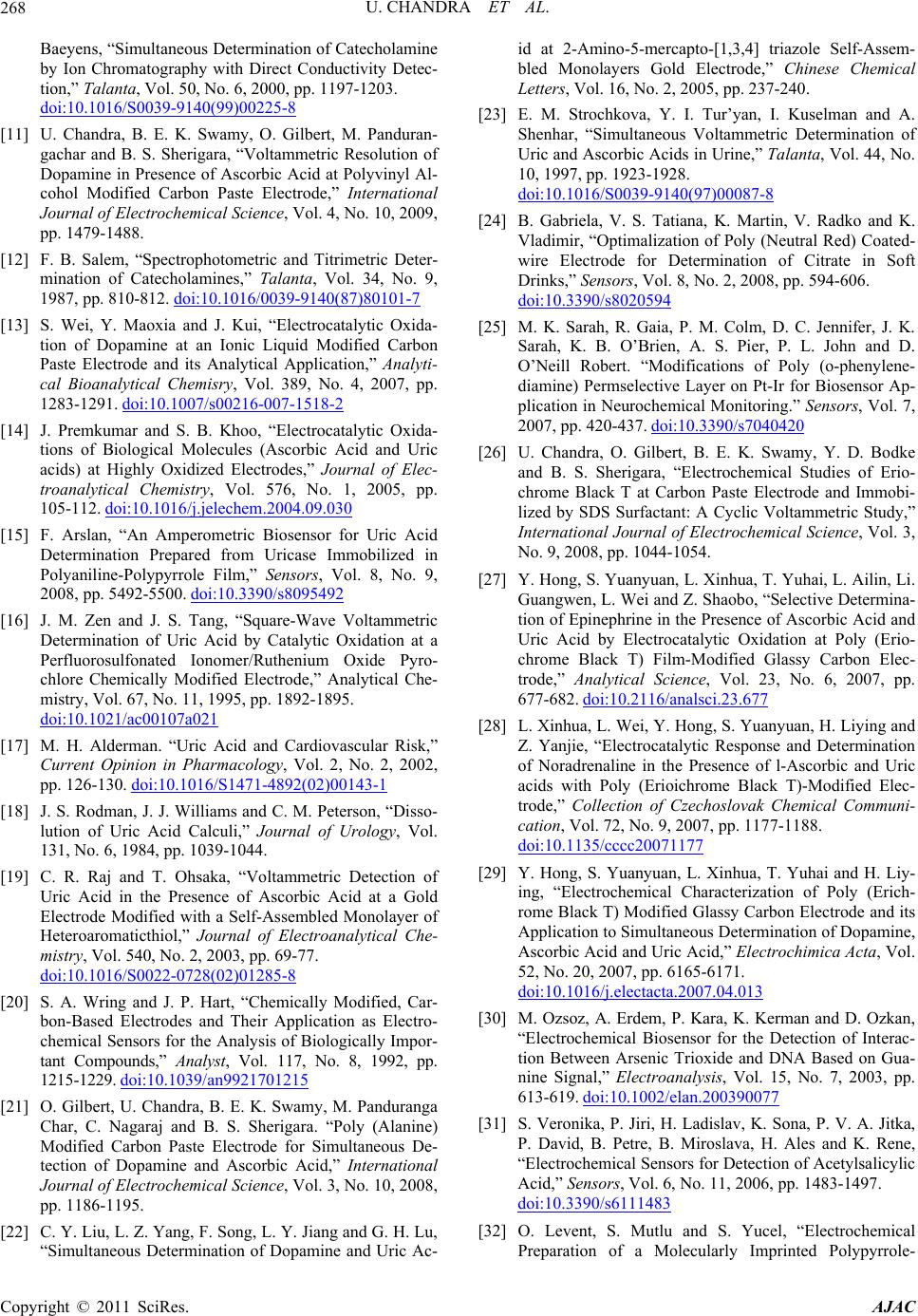
U. CHANDRA ET AL.
268
Baeyens, “Simultaneous Determination of Catecholamine
by Ion Chromatography with Direct Conductivity Detec-
tion,” Talanta, Vol. 50, No. 6, 2000, pp. 1197-1203.
doi:10.1016/S0039-9140(99)00225-8
[11] U. Chandra, B. E. K. Swamy, O. Gilbert, M. Panduran-
gachar and B. S. Sherigara, “Voltammetric Resolution of
Dopamine in Presence of Ascorbic Acid at Polyvinyl Al-
cohol Modified Carbon Paste Electrode,” International
Journal of Electrochemical Science, Vol. 4, No. 10, 2009,
pp. 1479-1488.
[12] F. B. Salem, “Spectrophotometric and Titrimetric Deter-
mination of Catecholamines,” Talanta, Vol. 34, No. 9,
1987, pp. 810-812. doi:10.1016/0039-9140(87)80101-7
[13] S. Wei, Y. Maoxia and J. Kui, “Electrocatalytic Oxida-
tion of Dopamine at an Ionic Liquid Modified Carbon
Paste Electrode and its Analytical Application,” Analyti-
cal Bioanalytical Chemisry, Vol. 389, No. 4, 2007, pp.
1283-1291. doi:10.1007/s00216-007-1518-2
[14] J. Premkumar and S. B. Khoo, “Electrocatalytic Oxida-
tions of Biological Molecules (Ascorbic Acid and Uric
acids) at Highly Oxidized Electrodes,” Journal of Elec-
troanalytical Chemistry, Vol. 576, No. 1, 2005, pp.
105-112. doi:10.1016/j.jelechem.2004.09.030
[15] F. Arslan, “An Amperometric Biosensor for Uric Acid
Determination Prepared from Uricase Immobilized in
Polyaniline-Polypyrrole Film,” Sensors, Vol. 8, No. 9,
2008, pp. 5492-5500. doi:10.3390/s8095492
[16] J. M. Zen and J. S. Tang, “Square-Wave Voltammetric
Determination of Uric Acid by Catalytic Oxidation at a
Perfluorosulfonated Ionomer/Ruthenium Oxide Pyro-
chlore Chemically Modified Electrode,” Analytical Che-
mistry, Vol. 67, No. 11, 1995, pp. 1892-1895.
doi:10.1021/ac00107a021
[17] M. H. Alderman. “Uric Acid and Cardiovascular Risk,”
Current Opinion in Pharmacology, Vol. 2, No. 2, 2002,
pp. 126-130. doi:10.1016/S1471-4892(02)00143-1
[18] J. S. Rodman, J. J. Williams and C. M. Peterson, “Disso-
lution of Uric Acid Calculi,” Journal of Urology, Vol.
131, No. 6, 1984, pp. 1039-1044.
[19] C. R. Raj and T. Ohsaka, “Voltammetric Detection of
Uric Acid in the Presence of Ascorbic Acid at a Gold
Electrode Modified with a Self-Assembled Monolayer of
Heteroaromaticthiol,” Journal of Electroanalytical Che-
mistry, Vol. 540, No. 2, 2003, pp. 69-77.
doi:10.1016/S0022-0728(02)01285-8
[20] S. A. Wring and J. P. Hart, “Chemically Modified, Car-
bon-Based Electrodes and Their Application as Electro-
chemical Sensors for the Analysis of Biologically Impor-
tant Compounds,” Analyst, Vol. 117, No. 8, 1992, pp.
1215-1229. doi:10.1039/an9921701215
[21] O. Gilbert, U. Chandra, B. E. K. Swamy, M. Panduranga
Char, C. Nagaraj and B. S. Sherigara. “Poly (Alanine)
Modified Carbon Paste Electrode for Simultaneous De-
tection of Dopamine and Ascorbic Acid,” International
Journal of Electrochemical Science, Vol. 3, No. 10, 2008,
pp. 1186-1195.
[22] C. Y. Liu, L. Z. Yang, F. Song, L. Y. Jiang and G. H. Lu,
“Simultaneous Determination of Dopamine and Uric Ac-
id at 2-Amino-5-mercapto-[1,3,4] triazole Self-Assem-
bled Monolayers Gold Electrode,” Chinese Chemical
Letters, Vol. 16, No. 2, 2005, pp. 237-240.
[23] E. M. Strochkova, Y. I. Tur’yan, I. Kuselman and A.
Shenhar, “Simultaneous Voltammetric Determination of
Uric and Ascorbic Acids in Urine,” Talanta, Vol. 44, No.
10, 1997, pp. 1923-1928.
doi:10.1016/S0039-9140(97)00087-8
[24] B. Gabriela, V. S. Tatiana, K. Martin, V. Radko and K.
Vladimir, “Optimalization of Poly (Neutral Red) Coated-
wire Electrode for Determination of Citrate in Soft
Drinks,” Sensors, Vol. 8, No. 2, 2008, pp. 594-606.
doi:10.3390/s8020594
[25] M. K. Sarah, R. Gaia, P. M. Colm, D. C. Jennifer, J. K.
Sarah, K. B. O’Brien, A. S. Pier, P. L. John and D.
O’Neill Robert. “Modifications of Poly (o-phenylene-
diamine) Permselective Layer on Pt-Ir for Biosensor Ap-
plication in Neurochemical Monitoring.” Sensors, Vol. 7,
2007, pp. 420-437. doi:10.3390/s7040420
[26] U. Chandra, O. Gilbert, B. E. K. Swamy, Y. D. Bodke
and B. S. Sherigara, “Electrochemical Studies of Erio-
chrome Black T at Carbon Paste Electrode and Immobi-
lized by SDS Surfactant: A Cyclic Voltammetric Study,”
International Journal of Electrochemical Science, Vol. 3,
No. 9, 2008, pp. 1044-1054.
[27] Y. Hong, S. Yuanyuan, L. Xinhua, T. Yuhai, L. Ailin, Li.
Guangwen, L. Wei and Z. Shaobo, “Selective Determina-
tion of Epinephrine in the Presence of Ascorbic Acid and
Uric Acid by Electrocatalytic Oxidation at Poly (Erio-
chrome Black T) Film-Modified Glassy Carbon Elec-
trode,” Analytical Science, Vol. 23, No. 6, 2007, pp.
677-682. doi:10.2116/analsci.23.677
[28] L. Xinhua, L. Wei, Y. Hong, S. Yuanyuan, H. Liying and
Z. Yanjie, “Electrocatalytic Response and Determination
of Noradrenaline in the Presence of l-Ascorbic and Uric
acids with Poly (Erioichrome Black T)-Modified Elec-
trode,” Collection of Czechoslovak Chemical Communi-
cation, Vol. 72, No. 9, 2007, pp. 1177-1188.
doi:10.1135/cccc20071177
[29] Y. Hong, S. Yuanyuan, L. Xinhua, T. Yuhai and H. Liy-
ing, “Electrochemical Characterization of Poly (Erich-
rome Black T) Modified Glassy Carbon Electrode and its
Application to Simultaneous Determination of Dopamine,
Ascorbic Acid and Uric Acid,” Electrochimica Acta, Vol.
52, No. 20, 2007, pp. 6165-6171.
doi:10.1016/j.electacta.2007.04.013
[30] M. Ozsoz, A. Erdem, P. Kara, K. Kerman and D. Ozkan,
“Electrochemical Biosensor for the Detection of Interac-
tion Between Arsenic Trioxide and DNA Based on Gua-
nine Signal,” Electroanalysis, Vol. 15, No. 7, 2003, pp.
613-619. doi:10.1002/elan.200390077
[31] S. Veronika, P. Jiri, H. Ladislav, K. Sona, P. V. A. Jitka,
P. David, B. Petre, B. Miroslava, H. Ales and K. Rene,
“Electrochemical Sensors for Detection of Acetylsalicylic
Acid,” Sensors, Vol. 6, No. 11, 2006, pp. 1483-1497.
doi:10.3390/s6111483
[32] O. Levent, S. Mutlu and S. Yucel, “Electrochemical
Preparation of a Molecularly Imprinted Polypyrrole-
Copyright © 2011 SciRes. AJAC